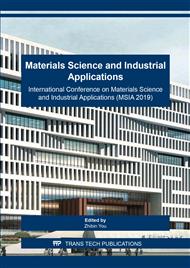[1]
When C.Y., Yu J.H., Yan Z.F., Jia Z.H., Hu N. Tao., Miao Y.P., Application of technology of gas recovery by foam drainage to tarim oilfield. Oil Drilling & Production Technology. 29(4) (2007) 100-101.
Google Scholar
[2]
Chen T., Song J.Y., Liu S.F., Huang X.S., Preparation and use of foaming agent for foam over drainage from gas wells. Oilfield Chemistry. 18(2) (2001) 115-116.
Google Scholar
[3]
Li N., Yan Y., Miao H., Liu C., Ai T., Yang X., Study on scale resisting and controlling ability of foaming agent for drainage. Natural Gas Industry. 25 (2005) 89-91.
Google Scholar
[4]
Zhang X.Z., Gao X., Li W.H., Liu Q.Y., Zhang Y.G., Li Z., Research in selection and application of foam drainage agent for natural gas wells. Fine Chemicals. 26(12) (2009) 1231-1234.
Google Scholar
[5]
Jie, Q., Wei W., Lei Z., Xiaojun Y., Wei L., Li X.Y., Research and development of fg-4 series solid defoaming agent and dosing device and their application. Natural Gas Industry. 34(2) (2014) 9.
Google Scholar
[6]
Li N., Zhao L.Q., Miao H.Y., Research and development of a heat-resistant foaming agent for deep wells and its experimental evaluation methods. Natural Gas Industry. 32(12) (2012) 55-57.
Google Scholar
[7]
Qiao S., Liu Q., Fan Z., Wang J., Xu J., Synthesis and analysis of foam drainage agent for gas well in Jilin oilfield. IOP Conference Series Earth and Environmental Science. 64 (2017) 4-5.
DOI: 10.1088/1755-1315/64/1/012025
Google Scholar
[8]
Lu K., Li R., Wu Z., Hou K., Du X., Zhao Y., Wall effect on rising foam drainage and its application to foam separation. Separation and Purification Technology. 118 (2013) 710-715.
DOI: 10.1016/j.seppur.2013.07.024
Google Scholar
[9]
Thevenot C., Grassl B., Bastiat G., Binana W., Aggregation number and critical micellar concentration of surfactant determined by time-dependent static light scattering and conductivity. Colloids & Surfaces A Physicochemical & Engineering Aspects. 252(2) (2005) 105-111.
DOI: 10.1016/j.colsurfa.2004.10.062
Google Scholar
[10]
Du X.G., Wang C.W., Niu R.Q., Zhang J., Yang Z.Y., Study on foam properties of alkylbenzene sulfonate gemini surfactants. Advanced Materials Research. 4 (2011) 418-420.
DOI: 10.4028/www.scientific.net/amr.418-420.528
Google Scholar
[11]
Samanta S., Ghosh P., Coalescence of bubbles and stability of foams in aqueous solutions of tween surfactants. Chemical Engineering Research & Design. 89(11) (2011) 2344-2355.
DOI: 10.1016/j.cherd.2011.04.006
Google Scholar
[12]
Ma X., Zhu Z., Dai L., Liu L., Wei S., Introducing hydroxyl into cationic surfactants as viscoelastic surfactant fracturing fluid with high temperature resistance. Russian Journal of Applied Chemistry. 89(12) (2016) 2016-2026.
DOI: 10.1134/s1070427216120132
Google Scholar
[13]
Mao J., Yang X., Chen Y., Zhang Z., Chong Z., Bo Y., Viscosity reduction mechanism in high temperature of a gemini viscoelastic surfactant (ves) fracturing fluid and effect of counter-ion salt (kcl) on its heat resistance Journal of Petroleum Science & Engineering. 164(2018) 189–195.
DOI: 10.1016/j.petrol.2018.01.052
Google Scholar
[14]
Zou Q.Y., Li Q.D., Xue D., Performance evaluation of foaming draining water agent YG-1 for gas wells. Journal of Xian Shiyou University. 28(5) (2013) 96-99.
Google Scholar
[15]
Alagic E., Spildo K., Skauge A., Solbakken J., Effect of crude oil ageing on low salinity and low salinity surfactant flooding. Journal of Petroleum Science & Engineering. 78(2) (2011)220-227.
DOI: 10.1016/j.petrol.2011.06.021
Google Scholar
[16]
Rocha A., Gomes V.P., Passos M., Furia R., Effects of anionic surfactant and salinity on the bioenergetics of juveniles of centropomus parallelus (poey). Ecotoxicology & Environmental Safety. 68(3) (2007) 397-404.
DOI: 10.1016/j.ecoenv.2006.10.007
Google Scholar


